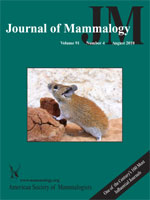Brazilian free-tailed bats (Tadarida brasiliensis) emerge from cave roosts in dense columns in which adjacent bats are separated by only small distances. We describe and quantify variation in the structure of echolocation calls produced by these emerging bats and determine if call structure changes in relation to the rate of emergence measured using thermal infrared imaging. We recorded emergence calls at 2 roosts, 1 housing approximately 200,000 bats and the other approximately 17,000 bats. We found that Brazilian free-tailed bats emit distinct frequency-modulated (FMstart) and constant frequency (CFstart) calls during emergence that are significantly different from echolocation calls they emit while foraging. We propose that these calls provide different information for orientation within the emergence column. CFstart calls are very similar to social calls used by Brazilian free-tailed bats, suggesting 2 potential functions for this call type. The structure of both the FMstart and CFstart calls were not related to the number of bats emerging from a roost, although significant structural differences existed between sites. The differences between sites could be associated with the spacing of bats during emergence, because bats appeared to form tighter columns at the larger roost colony compared to the smaller colony.
How to translate text using browser tools
16 August 2010
Echolocation behavior of Brazilian free-tailed bats during dense emergence flights
Erin H. Gillam,
Nickolay I. Hristov,
Thomas H. Kunz,
Gary F. McCracken
ACCESS THE FULL ARTICLE

Journal of Mammalogy
Vol. 91 • No. 4
August 2010
Vol. 91 • No. 4
August 2010
bats
echolocation
emergence
Tadarida




